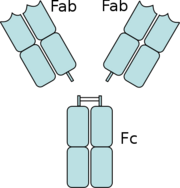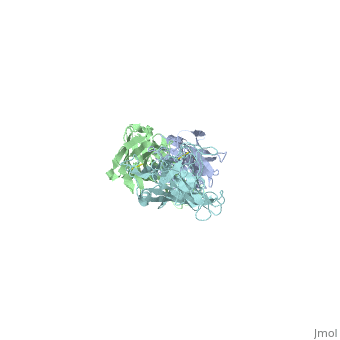User:Marvin O'Neal/Antibody OspA and OspB
From Proteopedia
| Line 6: | Line 6: | ||
===Fragment Antigen Binding (fab) Reigon=== | ===Fragment Antigen Binding (fab) Reigon=== | ||
[[Image:Fab reigon.png|right|thumb|Digestion of an antibody by Papain separates the fab reigons from the antibody]] | [[Image:Fab reigon.png|right|thumb|Digestion of an antibody by Papain separates the fab reigons from the antibody]] | ||
| - | There are two fab reigons per antibody, | + | There are two fab reigons per antibody, each fab is composed of both a variable and constant reigon. The variable region contains the [http://en.wikipedia.org/wiki/Paratope paratope], which recognizes the antigen [http://en.wikipedia.org/wiki/Epitope epitope], located at the N terminus of both the heavy and light chains of the fab. The complement-independent fab regions that interact with these outer surface proteins are LA-2, which targets the C-terminal of OspA, and CB2 and H6831, which target the C-terminal of OspB. <ref>PMID:107164</ref> |
Revision as of 17:16, 29 April 2012
Contents |
Introduction
Borrelia burgdoferi
The causative agent of Lyme disease is Borellia burgdorferi, a spirochaete found in the gut of hard bodied ticks of genus Ixodes. A factor contributing to the severity of Lyme disease is its resistance to certain forms of complement-dependent immune response by the evasion of the alternative complement pathway, and the blocking of complement C3. [1] This resistance increases the importance of the complement independent immune response when combating B. burgdorferi in vivo. The fragment antigen binding regions of IgG and IgM monoclonal antibodies to OspA and OspB, outer surface proteins of B. burgdoferi leads to a complement-independent lysis of the bacteria.[2]
Fragment Antigen Binding (fab) Reigon
There are two fab reigons per antibody, each fab is composed of both a variable and constant reigon. The variable region contains the paratope, which recognizes the antigen epitope, located at the N terminus of both the heavy and light chains of the fab. The complement-independent fab regions that interact with these outer surface proteins are LA-2, which targets the C-terminal of OspA, and CB2 and H6831, which target the C-terminal of OspB. [3]
OspB and H6831
|
Complex Interaction between OspB and H6831
Fab-Osp complexes, such as the OspB-H6831 complex, consist of two main components; the (OspB in this case), and the , which is subdivided into the , and the . Most hydrogen bonds and electrostatic interactions that are responsible for the binding of H6831 to OspB are between the three adjacent surface-exposed at the C-terminal of OspB and some on the fab heavy chain that include tyrosine, tryptophan, glutamate, and histidine. The majority of the electrostatic and hydrogen-bonded interactions are between loop 2 (residues 250-254) and the fab heavy chain. in loop 2 of OspB has a necessary and major role due to its central position in the exposed loops. A mutation at its position abrogates the binding interaction and causes the resistance of the bacteria to the bactericidal effect of the fab. Lys 253 binds to the two aromatic residues on the fab heavy chain, tyrosine (green link) and tryptophan (green link). It also makes hydrogen bonds with the glutamate (green link) in the heavy chain of the fab and forms an ionic bond. Carbonyl in loop 1 (green link) of the OspB interacts with histidine in the fab heavy chain. of OspB interacts with fab light chain. [4].
Conformational Changes to OspB
The binding leads to some conformational changes in OspB. Whereas Ding et al.[5] found no changes in the C-terminal of OspA upon the binding to the fab. The most significant difference between the free and the complexed structure of OspB is the loss of the central strands 1-4. Both small positional shifts near the Fab binding site and a few larger structural changes away from the binding site were observed. The largest shifts (7– 8 Å) correspond to the repositioning of a loop opposite the Fab-binding site (residues 218 –220). In the free OspB structure, all regions that exhibit shifts are adjacent to the central sheet; in the OspB-H6831 complex they all shift toward, and slightly overlap, the position of the missing sheet. These observations suggest that the larger conformational changes are related to the loss of the central sheet, which could have happened through proteolytic cleavage or fortuitous crystal contacts [6]
Requirements for the Bactericidal Effect and Proposed Mechanism
The fab binding destabilizes the outer membrane (OM) of B. burdorferi, with subsequent formation of spheroplasts. It has been observed that the bactericidal action, but not the binding, requires the presence of bivalent cations (Mg2+ and Ca2+). Escudero et al. study demonstrated the inability of fab to kill bacteria in the absence of the bivalent cations. It was speculated that OspB- Cb2 (a fab similar to H6831) complexes could create physical openings in the OM allowing for rapid infusion of electrolytes, increasing the osmolarity of the periplasm and triggering bivalent cation dependent cascades [7]. Need to be rephrased and squeezed and may be a sentence about the cholestrol needs to be added and if there is a specific function for the charge triad it may be added
OspA and LA-2
|
Temporary Stuff
IgG antibody fabs CB2 and are structurally similar and both target the C-terminal of . H6831 consists of a and a chain and each chain is composed of a variable and a constant domain. The paratope is located at the N terminal of the variable region of both the heavy and the light chains (Putnam 1979). Fab binding destabilizes the outer membrane (OM) of B. burdorferi with subsequent formation of spheroplasts. It has been observed that the bactericidal action upon binding requires the presence of bivalent cations (Mg2+ and Ca2+). When a similar fab, CB2, is bound to OspB, channels open in the OM allowing rapid infusion of electrolytes,increasing the osmolarity of the periplasm and triggering bivalent cation dependent cascades [8]
- When bound to a similar fab CB2, OspB-CB2 complexes could create physical openings in the OM allowing for rapid infusion of electrolytes, increasing the osmolarity of the periplasm and triggering bivalent cation dependent cascades [9]##
- ↑ LaRocca TJ, Benach JL. The important and diverse roles of antibodies in the host response to Borrelia infections. Curr Top Microbiol Immunol. 2008;319:63-103. PMID:18080415
- ↑ Connolly SE, Benach JL. The versatile roles of antibodies in Borrelia infections. Nat Rev Microbiol. 2005 May;3(5):411-20. PMID:15864264 doi:10.1038/nrmicro1149
- ↑ Putnam FW, Liu YS, Low TL. Primary structure of a human IgA1 immunoglobulin. IV. Streptococcal IgA1 protease, digestion, Fab and Fc fragments, and the complete amino acid sequence of the alpha 1 heavy chain. J Biol Chem. 1979 Apr 25;254(8):2865-74. PMID:107164
- ↑ Becker; Bunikis et al. 2004
- ↑ Ding et al
- ↑ Becker; Bunikis et al. 2004
- ↑ Escudero; Halluska et al. 1997
- ↑ Escudero R, Halluska ML, Backenson PB, Coleman JL, Benach JL. Characterization of the physiological requirements for the bactericidal effects of a monoclonal antibody to OspB of Borrelia burgdorferi by confocal microscopy. Infect Immun. 1997 May;65(5):1908-15. PMID:9125579
- ↑ Escudero; Halluska et al. 1997
Proteopedia Page Contributors and Editors (what is this?)
Christopher Smilios, Philip J. Pipitone, Safa Abdelhakim, Alexandros Konstantinidis, Jaime Prilusky


